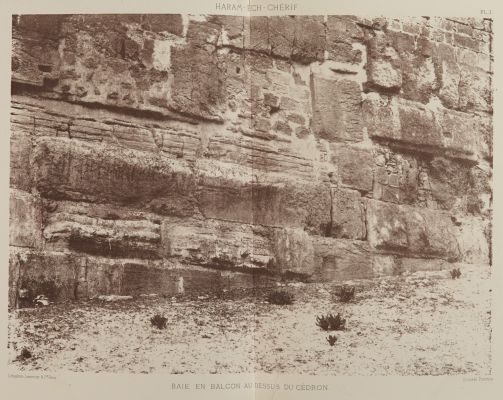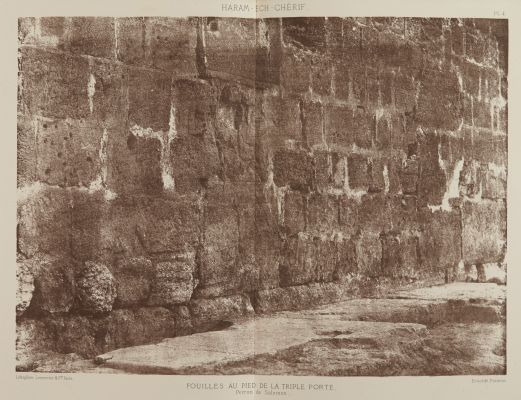
Title
Angle Nord-Est du TempleArtist
Salzmann, Auguste (French, 1824-1872)Publication
Voyage en Terre SainteDate
1867Process
Photolithograph (Poitevin process)Atelier
PoitevinImage Size
20.5 x 26.7 cm
Auguste Salzmann’s Jerusalem (1854) is a famous early photographic book. Its purpose was to document Félicien de Saulcy’s theories on the construction of the ancient architecture of Jerusalem. The present work resulted from a second voyage to the Holy Land undertaken by De Saulcy and Salzmann in 1863; it is not widely known and is rare. The object of this second voyage and the present publication was to refute the objections to de Saulcy’s theories by philologist Ernest Renan. For this publication De Saulcy included 11 additional Salzmann images. According to the Louvre exhibition catalogue by Francoise Heilbrun F. De Saulcy et le Terre Sainte (1982) the original calotypes Salzmann made on this trip are lost. The present publication is thus the only record of them. Of the Salzmann images Ken Jacobson has written: “As soon as the photographs were published, critics noticed “un caractere tout particulier.” These close-up views of archaeological detail, redolent with alternative swathes of light and shade, strike us today as the epitome of modernism, but at the time they were some of the first of their kind in the history of photography. Salzmann had successfully bolstered De Salucy’s historical case, but in the process also created a mysterious set of images that appeal to current curatorial sensibilities.” [1]
The photolithographs were made by Poitevin, commissioned by Lemercier, who co-owned the rights to the process. Poitevin’s process was crowned in 1867 (the year of the publication) by the grand prize of the Concours du Duc de Luynes. Coincidentally the Duc de Luynes himself was working on a similar project, Voyage D’Exploration a La Mer Morte, for which he commissioned Charles Négre to make photogravures from negatives of photographer Louis Vignes. The collodion negatives were made on an expedition to Ottoman-controlled Syria, Palestine, and Jordan. Most likely the Duc chose Négre for his project because Vignes’ negatives were poorly crafted and damaged requiring significant retouching. Négre had a background as a painter and was capable of ‘improving’ them. Perhaps the Duc himself also preferred the aesthetic of the photogravure process.
This work is therefore interesting on three counts: from an archaeological point of view, from an aesthetic point of view and from a technical point of view, as it encapsulates the very moment when photolithography and photogravure were competing head-to-head for the favor of the publishing industry in France. The present edition, which was published by the Institut Imperial de France turned out to be very expensive and almost bankrupted the publisher. The edition was thus limited to 200 copies.
Reproduced / Exhibited
MFA Boston accession number 2009.5065
References
[1] Jacobson K. Odalisques & Arabesques : Orientalist Photography 1839-1925. London: Quaritch; 2007, p. 267
Solomon-Godeau, Abigail. “A Photographer in Jerusalem, 1855: Auguste Salzmann and His Times.” October 18 (Autumn 1981): 90–107.
Heilbrun F. (1982). Auguste Salzmann, photographer in spite of himself. In F. de Saulcy (1807-1880) and the Holy Land, Paris, RMN, 1982. Notes et documents des Musées de France , 5, p. 114-182.
D’encre Et De Charbon: Le Concours Photographique Du Duc De Luynes 1856-1867. Paris: BibliotheÌque nationale, 1994 No. 43
Charles Wood Catalog136 # 191
Lewis JW. Charles Negre in Pursuit of the Photographic. 2012.
Addleman-Frankel, Kate, Dividing Lines – Early Photogravure, Reproduction, and the History of Photography, Department of Art History University of Toronto 2019
Borcoman, James. Charles Negre. Ottawa: Galerie nationale du Canada, 1976.











